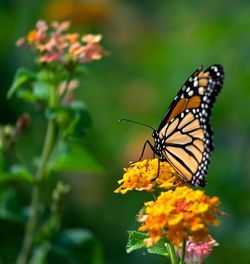Create a Monarch Habitat and Make a Difference
 Create a Monarch Habitat and Make a Difference
Create a Monarch Habitat and Make a Difference
Milkweed is the only plant where female monarchs will lay their eggs...

Most of us, when we think of what a butterfly looks like, think of the Monarch butterfly. With their large wings fluttering the bright orange, black and white colored markings, their striking beauty is hard to ignore. However, in the past several years, scientists are concerned about the fate of the beautiful Monarch butterflies. As children, most of us remember seeing butterflies every time we played in the backyard but now, their numbers are plummeting in Illinois and other parts of North America.
Based on a website, http://monarchjointventure.org/, one of the main reasons believed to be causing the drop in Monarchs is a decrease in the milkweed plant. The Monarch butterfly population dropped 81% between 1999-2010. In this time period, the number of milkweeds in the region fell to 58% too. These numbers are based on the Insect Conservation and Diversity Journal.
Why the correlation? Well, milkweed is the only plant where female monarchs will lay their eggs. Once the caterpillar is born, they feed on the milkweed plant about two weeks until it’s ready to form the chrysalis. The milkweed toxins stay in their body’s system as they go through metamorphosis. The adult butterfly then emerges, and the milkweed has contributed to not only a creature that is quite beautiful, but one that is also poisonous to potential predators.
How can you help? State officials and other groups are asking the community to help out by planting milkweeds. Native plants like milkweed can be added to homeowner’s landscaping, offering the rustic look that many find attractive now anyway. By incorporating a little “prairie” into your yard, you can truly make a difference. Also, if you do live in a rural area, it’s best to not mow roadside ditches until the end of August (which is after Monarch larvae has matured).
Some other gardening tips for the person wanting to create a Monarch butterfly habitat:
- Plant your gardens in sunny spots, protected from the wind.
- Plant at least one milkweed species native to your area.
- Add a variety of nectar plants with staggered blooming times to give butterflies and other pollinators a continuous food source.
- Avoid pesticides and herbicides because they can hurt caterpillars and adults.
Contact any staff member at Joe’s Market Basket to learn more about creating a wonderful habitat for the Monarch butterfly. With four convenient locations to choose from, it’s easy to see why our family-owned and operated nursery can’t be beat. Let us help you create the landscape you’ve always dreamed about and one that also serves a purpose: monarch butterfly conservation.


